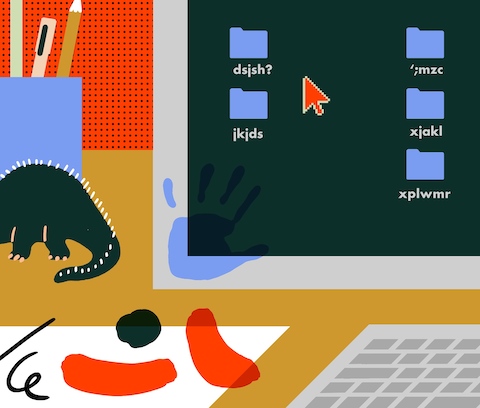In the late 1990s, Herman Miller published jugglezine, an early blog focused on work-life balance. This guide from 1999 shares a glimpse of what WFH life was like for parents pulling double-duty during the dot-com era—replete with fax machines, Zip drives, and answering machines. Many of the benefits and challenges remain just as relevant today, as many of our teams at Herman Miller—and as much as one third of the general population—suddenly find ourselves working from home indefinitely. We thought we’d reshare a peek at this balancing act.
There are a number of articles (entire books, even) out there giving practical and sober advice about how to set up a home office if you are telecommuting (working from home) or self-employed. They tell you about the equipment you'll need, the space, the furniture, the number of phone lines and electrical outlets. As a home-working parent, though, I find that these how-tos fail to inform one on the really crucial issues, such as the importance of having a mute button on your phone and a couch in your office, the benefits of stocking one file drawer with assorted Matchbox cars, and how many pens you will need if you share your workspace with a four-year-old (a lot more than you think).
Actually, I wish I had a sharp, red, never-been-used-for-colouring-firetrucks Pilot Razor Point pen for every time I've read the cautionary sentence: "Telecommuting is not a substitute for childcare." As my 11-year-old home-schooled office mate would put it: No duh. Telecommuting is a substitute for working in a place where you can only look at pictures of your children.
True, in the pictures they're always smiling and never inserting experimental materials into your Zip drive, but they're also not illuminating your thinking with discourses on the physics of Rocky and Bullwinkle cartoons or charming you with professions of undying love. I will never forget the day several years ago when Emerson came into my office wearing a cowboy hat, a Robin Hood cape, and several pieces of plastic armour. "Who are you?" I asked, overwhelmed by sartorial splendour. "Mum," he said, in a slightly hurt voice, "I am the man of your dreams." This sort of thing never happens in a cubicle.

Although it is not easy and it is not for every parent and it is most assuredly not recommended by the Emily Posts of telecommuting and self-employment etiquette, it is possible to work and to care for children at the same time and in the same room. You just have to really want to do it. So, if you find yourself thinking that working in a corporate office is no substitute for experiencing the daily life of your amazing offspring and you discover within yourself a secret yearning to share a workspace with people you really love, go for it. Herewith, a few troubleshooting tips.
Your preschooler renames all your desktop files.
This is what's known in child development circles as a “teachable moment.”
Recognising that certain combinations of letters (“draft”) form words while other combinations of letters (“xplwmr”) do not is an important pre-reading skill. Point out this distinction to your child as you identify and relabel your files, first reading his names (egs-plew-mur), then yours.
After you have both had a good laugh and a beginning phonics lesson, tell him: “Don't ever do that again.”
You’re in the middle of an international conference call when your child rushes into your office, bleeding profusely.
Hit that mute button.
Homeworking parents must become adept at on-the-spot triage. Assess the severity of the injury. If you’re able to staunch the wound and are certain the child is going to live, make a sympathetic face, give a hug, and offer a matchbox car, a Barbie Band-Aid, 30 minutes of Internet access.
If you’re looking at a trip to the ER, get back on the phone and say “I'm afraid I’ll have to reschedule this call. My child is bleeding profusely.” Most people will understand your priorities here. Those who don't are not destined to be long-term clients or employers of yours anyway.
Your first-born overwrites your back-up disk with a download of “Marathon II.”
If he’s old enough to be decapitating aliens, he’s ready for the Facts of Life. Explain to him that that was your work on that disk and that your work is what people pay you to do and that without that work people won’t pay you and there will be no money for Dungeons and Dragons role-playing books.
The next time you go to Staples, buy him his own box of disks.
You’re working against a deadline and someone small and dear to your heart wants you to read him “The Runaway Bunny.”
Do it. Save your work. Scoop him up in your lap, lean back in your ergonomically supportive chair and read him the story. It will take 5 minutes.
You need 10 copies of a report outline for your meeting. Your teenager needs a ride to Band practice.
This one should be a no-brainer: he makes the copies, you make the trip. Remember that there are many office tasks that can be performed by people under the age of 18. Maria Montessori built an entire educational philosophy around an understanding of the importance of children's “work” and the notion that an ideal learning environment is one in which work and play are the same thing.
Copying, collating, sorting the mail, licking the stamps, feeding the fax machine, cleaning up the hard drive are all tasks which my own children have considered “fun” at certain stages of their lives and been willing to trade for services at others. I have found that the risks involved in letting them attempt these things while they still find them interesting are outweighed by the learning that takes place and the eventual benefits of free in-house tech support.

You’re back to working against that deadline and someone small and dear to your heart wants you to read him “The Runaway Bunny” again.
Say gently but firmly, “That’s enough reading for now. I have to work.” If he persists, say: “Here, let me read you my story.” Scoop him up in your lap, lean back in your ergonomically supportive chair, and read him the statistically significant findings of the exceptionally arcane laboratory study you are attempting to translate into regular English. Before you even get to the footnotes, he’ll pat you on the arm and say, “That’s enough reading for now. I have to get to work.”
It’s 3:00 on a late August afternoon and all three of your children come into your office together and look at you with six big brown eyes and the youngest, elected spokesman, says, “Mummy, take us to the beach before it’s too late.”
Save your work. Close the application. Turn on the answering machine. Take them to the beach, before it's too late.





